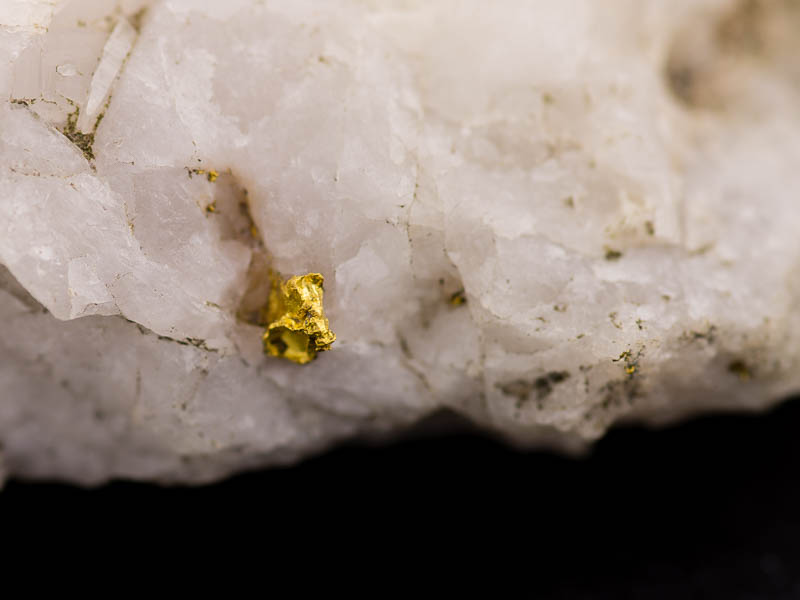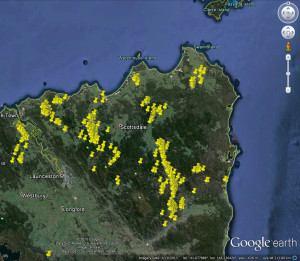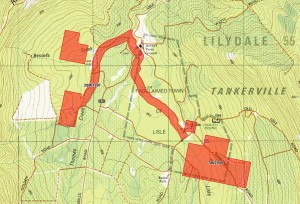This week I’m writing about an area that contains some of our earliest gold discoveries — the north-east. I will discuss a bit of history, linking to newspaper articles from the times of the original discoveries. I also go over places worth a try if you want to find some gold, and finally there’s a section on how I go about finding information by searching online resources. There is quite a bit of information in this post, so I recommend grabbing yourself a cuppa before you start!
A bit of history
Although compared to the rest of Australia, Tasmania did not stand out as a large gold producer, it had some significant goldfields. Their discovery kicked off the State’s metal mining industry almost single-handedly, and was responsible for a period of prosperity in the second half of the 19th Century that was unprecedented in Tasmania’s history. The first discoveries of Tasmanian goldfields were almost certainly in the northeast part of the State.
Mangana, near Fingal, was the first official gold discovery in Tasmania. There is some speculation that gold was first discovered a little earlier in either Beaconsfield or Nine Mile Springs (modern Lefroy), but Mangana was the first undisputed discovery. Prospectors gradually started exploring the surrounding country, and by 1856 some parties reported having found gold at “The Blackboy” (nowadays Mathinna). This would go on to become one of the most important Tasmanian goldfields, with the New Golden Gate mine producing about 289,000 ounces of gold in its main period of activity from 1880 to 1932.
By 1857, newspapers report parties were prospecting gold discoveries in the South Esk River, Lake River, Nine Mile Springs, Waterhouse, and possibly Bangor or Back Creek (described as “an old slate quarry“). However, serious attention wasn’t paid to some of those districts until ten or more years later. Important later gold discoveries in the north-east were Denison/Golconda (1872), Lisle (1878), and Gladstone (1880).
The main northeast Tasmanian goldfields
As you can see in the picture, goldfields don’t occur randomly, and most of the ones in the north-east are in one of two approximately straight lines, one from Waterhouse south to Mangana, and another from Lefroy south-east to Golden Hill, near Blessington, with minor fields outside this. This is a list of all the northeast Tasmanian goldfields I have found records for (some have more than one name historically):
- Gladstone — North Mt Cameron
- Lyndhurst — Waterhouse
- Forester — Mt Horror
- Warrentina — Branxholm
- Alberton — Mt Victoria
- Dan Rivulet — South Mt Victoria
- Mathinna — The Blackboy — Reedy Marsh
- Tower Hill
- Mangana — The Nook
- Golden Ridge — Brilliant Creek
- Denison — Golconda
- Cradle and Tobacco Creeks
- Lisle — Mt Arthur
- Lone Star Creek
- St Patricks River
- Camden Plains
- Diddleum Plains
- Lebrina
- The Den
- The Glen
- Lefroy — Nine Mile Springs
- Back Creek
- Beaconsfield
- Salisbury
Now, some of these were proper goldfields (e.g. Beaconsfield, Lefroy, Mathinna, Gladstone), while others are more like small shows or small occurrences that had little economic value. There are plenty of isolated occurrences. If you want to know the exact localities where gold has been found throughout Tasmania, I’ve put together a Google Earth .kmz file containing every occurrence listed in the Tasmanian Government’s mineral database. If you find it useful, please let me know!
Do you just want to go panning for gold?
If you’re just interested in going panning for gold, Lisle is a good bet, though the gold is very fine, and picker-size pieces are rare, let alone nuggets. The main creeks are Lisle Creek and Bessells Creek. They both produced good gold, though Lisle Ck was the most important one. Be aware that part of the Lisle area is a mining lease, and you should ask for permission. In order to find where the leases are, go to MRTmap, click on ‘Layers’ (top right), click ‘Add Layer’, click on ‘Tenements’, and then the little green plus button next to ‘Mining Leases’. This will overlay all active mining leases over the map of Tasmania. If you click on a lease, it’ll bring up the details, and you can find out who the lease belongs to. By clicking on the Details line, you can see the contact details and other info on the lease and leaseholder. Depending on the map base you use, you’ll get something that looks like this:
Near Lisle, I’ve panned some slightly coarser, but still fairly fine gold at Tobacco Creek.
The area around St Patricks River, Patersonia Rivulet, Camden Plains and Diddleum Plains was worked by casual prospectors during the 1930s depression, and would be worth exploring. Be aware that a lot of it is within private property, so you’ll need to arrange permission. Majors Gully in Mangana, which has been mined for 160+ years, still has a little bit of gold in potholes and cracks in the slate, especially if you find a patch that wasn’t gone over thoroughly in the past. Again Mangana is mostly both private property and under current exploration tenements, so permissions are a must. Outside of this area, but relatively near Launceston, the boat ramp at Hadspen is said to be a good spot, though I’ve never tried there myself.
What about metal detecting?
I have found some small nuggets in the Beaconsfield, Lefroy, Back Creek and Mangana areas. If you’re interested in detecting in the north-east Tasmanian goldfields, then a detector sensitive to small gold is a must. I have had the best success detecting over mullock heaps from old-timers’ diggings, and in slaty creek beds, where the nuggets can get caught in cracks.
If you’re heading to the area, again keep in mind which parts are private property, as well as covered in exploration licences. You’ll want to organise land-owners and exploration company permissions before you head out. The Back Creek area has several active mining leases over it, so again, so you’ll need a good map or GPS marked with lease boundaries or to organise permission. Another thing to keep in mind is that the legality of metal detectors in Tasmania is still not totally clear. My position on this is that they are a hand-held instrument, and not motorised, so they should comply with the current rules on prospecting licences.
As you can see from the Google Earth image I showed above, there are plenty of areas where gold has been found, and I’ve only covered a small percentage of Tasmanian goldfields myself, so there’s plenty of country to explore. Multi-ounce nuggets have been reported from the Beaconsfield area, Denison goldfield, Mangana, Mathinna, Lefroy, and Back Creek, at least that I could find, possibly others. For a more comprehensive list, check out my Database of Historical Tasmanian Gold Nuggets.
Finding information
You probably saw some links in my first post to articles and information in the Mineral Resources Tasmania (MRT) library. It is an extremely useful resource, where you can find anything from scans of 19th-century reports of original gold discoveries, to recent exploration reports by mining companies.
At the end of the day, there’s no substitute for doing your own research, and you might find that little pearl of hidden information that leads to a good find. The MRT library is now online and searchable by Google. Since they only link to a tiny proportion of the content that is publicly available, the best way to search it is using Google, by typing site:mrt.tas.gov.au YOUR SEARCH HERE into the search box, like this:
Combined with this, The National Library of Australia’s Trove database contains scanned copies of virtually every Australian newspaper published before 1955. There is a HUGE amount of information to be found there, and you can narrow down your searches by State, time period, and even individual publications.
I will eventually write some posts on individual Tasmanian goldfields, but hopefully this is enough to get started! Is there anything else you’d like to know about? If you like the content at Apple Isle Prospector, feel free to get in contact, or leave a comment.





Thanks you mad bugger. excellent site. lots of info. cheers to you.
Thanks, I’m glad you think it’s useful!
Awesome info….im looking at buying the best detector for gold prospecting….wish i had someone like you to show me the ropes and find gold together….ive have been detecting for 2 years now and found heaps…but now its time for gold prospecting….would like to talk to you personally on the subject of gold. ..you have my email address
Regards jason
Hi Jason,
I’ll get in contact through Facebook, I think we’re both in the Pingers and Swingers group.
Thanks so much for the info you have provided here. I am a newbie but have had a secret desire to have a go for yrs. I have a second hand metal detector which I was assured was a good (ish) one but have not been able to figure out how to set the discriminating on it even though I have read the manual over and over. Would love some help with it. I am also keen to have a go at those sapphires in the northeast, just hope I can persuade hubby to come along.
Kind Regards
Mary
Thanks Mary,
YouTube can be a good tool if your detector isn’t too old. There are a lot of videos of people setting up their detectors. I’m only familiar with my own detectors, so I don’t know if I’d be able to help you. Get in touch through the Contact Form and we’ll see. There was a metal-detecting club in Hobart formed a couple of years ago, but I don’t know anything about them.
As an aside, if you’re looking for gold you shouldn’t be using any kind of discrimination.
Thanks for all your great posts and advice, Miguel! You are indeed a godsend for newbies!
Thanks Warren, I’m glad you find it useful!
Thank you so much for this info, we are heading over in Feb and had no idea where to start then I found your post, I am a member of the PMAV and my brother in law and I along with my sister and my wife will be bringing 2 SDC 2300’s leave the 5000 and 7000 at home, we hope to find some Tassie gold. Regards
No worries!
I’m a PMAV member myself. I have had better success finding nuggets in the creeks on the west coast, mostly with the SDC.
Just a word of warning, detecting down here is pretty different to the GT! The small coil of the SDC makes it a bit easier but be prepared for pretty impenetrable scrub.
Good luck!
Hi There,
Have been hitting a few fields with my Sdc. No luck as yet but would be great to get some tips on using the sensitivity selectors. I live not for from the lefroy fields. Been all over those and also back creek with not alot of luck. .. only if lead was a higher sale price lol
If you’re finding little lead shot you’re doing it right, you just haven’t swung over gold yet. I usually have my threshold on 3, because I like an audible threshold. Sensitivity I usually start on default (2), and crank it up if it’s stable ground / emi. I’ve run as high as 4, but often 2/3. My ear gets tired of the wavery threshold with the higher sensitivity and I miss nuggets.
I’ve found gold in both Back Creek and Lefroy, but both are getting pretty picked over, as is everywhere else unfortunately. Rumour has it that a 20 gram nugget was found in the area a few weeks ago. I’d say stick to lines of obvious alluvial workings for starts, till you’re a bit more confident.
I’ve now switched to doing virtually all my detecting on the West Coast. Plenty of ground there it you’re prepared to walk and brave the scrub.
Hi, what a great site you have!
Looking to go detecting and panning Beaconsfield way, any recommendations on which creeks to look at ? Dont know the area well.
Thanks Bruce!
Both Brandy Creek and Middle Arm Creek had alluvial workings on them. The trick is to find available ground or swing the right permissions. There is virtually no open and available land in Beaconsfield.